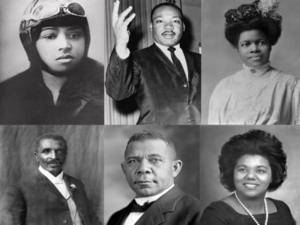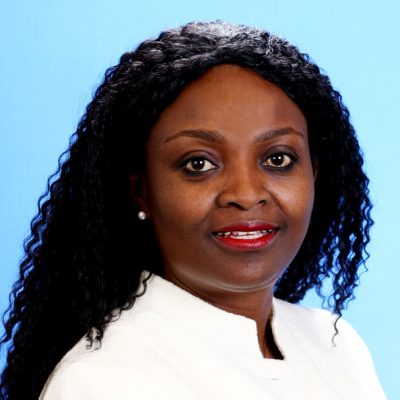Tag Archive for: Black History Month
By Cathie Ericson
Don’t let your inner critic get the best of you, advises Citi’s Bola Oyesanya.
“Confidence is so important, so embrace who you are because it’s what makes you unique,” she says. She herself learned this firsthand, when earlier in her career she regarded her Nigerian accent as a potential issue, which even led her to talk herself out of some client-facing jobs. Her colleagues had assured her that her accent was an advantage as it made her memorable, but a defining moment came when a client mentioned that she liked her voice. “Don’t ever tell yourself that the things that make you different are a problem,” she says.
Finding Her Niche
Although she was trained as an attorney, Bola pivoted and began her career in Nigeria in banking, including doing a stint with the oil and gas industry group within a bank. She came to the United States in 1999 and started with Citi, where she has spent the past 20 years in a variety of roles from customer service representative to junior banker. She became a private banker in 2008 in Citi Private Bank’s Law Firm Group, where she remains today, working with law firms and individual attorneys, as well as institutions that work with the legal industry.
“Nothing gets me more excited than being my clients’ advocate; of course, it’s my job, but I love it,” she says. “As long as I have my clients’ best interest at heart, everything will fall into place,” she says, noting that you need to carry your team along to get the best for your clients. “There’s nothing better than when we are all aligned.”
Bola was promoted to managing director this year, a milestone achievement of which she’s very proud, noting that it was both exciting and humbling – exciting to see hard work recognized, but humbling because she knows that her recognition opens the door for others and serves as motivation for younger bankers.
Channeling Her Passion for Diversity into Action
In her other role, Bola is part of the Citi Private Bank diversity leadership team, whose mission is to recruit, train and retain employees, making Citi the employer of choice for new and seasoned talent. She finds the diversity philosophy at Citi organic, rather than top down, with a good mix of levels from managing directors to junior analysts who all have a voice.
She says the group prides itself on starting the year with a blank slate to come up with new goals and the paths to get there. The leadership then helps build teams around these ideas to start implementing them.
One recent initiative was Citi Coffee Chats, which allowed colleagues to get to know senior leaders beyond their work success and professional bio, with questions focused on a more personal angle, such as their family and philanthropy interests.
The group works on skills to help manage careers upwards, but also down and sideways, taking into account peers and direct reports.
Having always been personally passionate about diversity and inclusion, she finds it exciting that the topic is now a priority. “We used to have to convince people to consider diversity, and it’s refreshing that now even clients are asking what we’re doing on that front,” Bola says, adding that it’s no longer just a “nice to do.”
“It’s who we are, and it isn’t just about gender or culture, but also includes diversity of thought. The more diverse we are, the better we can meet our clients’ needs,” she says, adding that the firm’s many locations and cultures means they can leverage the power of their global reach.
Proud of Citi’s success in retaining women talent, she has realized that while it’s easy to assume that all firms are as committed, the numbers show that Citi is quite far ahead in the industry: Forty percent of the leadership of Citi Private Bank in North America are women, including the CEO, and the overall diversity numbers climb to 60% when you include LGBT, cultural and ethnic minorities.
Giving and Receiving Mentorship Has Contributed to Career Success
While diversity initiatives are important, Bola also believes in the power of combining them with mentoring programs, which will double the networking and connection potential. She advises other women to look for people who are genuinely interested in them and will offer candid feedback. “If they care about your career, they will offer advice on both sides of the coin,” she notes.
Bola herself felt particularly supported during a diversity leadership program in 2010, which was focused on developing midlevel diverse employees. “What was so powerful was that each participant was the agenda, with one-on-one coaching tailored to exactly what you needed to build a career,” she says. Among the most valuable aspects were sessions devoted to developing your brand and your executive presence — lifelong skills that helped the employee but also ultimately Citi as a whole.
Recently someone asked her what she would do if money was no barrier, and the answer came to her immediately. “I would be a motivational speaker,” she says. “I love to inspire others and do a lot of one-on-one mentoring. So many senior women and men have invested in me, and the best way to say thank you is to pay it forward.”
In fact, she frequently recommends that her peers remember what it feels like to be sidetracked and commit to helping and encouraging each other. For her part, she enjoys working with younger professionals and often reminds them to be patient and know they will eventually get to the destination. “There might be detours, but you have to see them as learning points. Then don’t waste your energy and emotion focusing there, but rather on how to get back on track.”
While her work and diversity efforts are important, there is one aspect of her life that takes precedence – her family. Bola says her most precious time is spent talking and spending time with her eight-year-old daughter and husband, particularly when they are traveling and meeting people and learning new cultures together.
By Aimee Hansen
Even though 2017 was a record year for women in the C-Suite amidst Fortune 500 companies (32 women in CEO jobs, vs. 21 in 2016) , no African American women have sat at the helm since Ursula Burns stepping down at Xerox in late 2016.
Soon there will be only three black CEOs at all in the Fortune 500, against a peak of seven in 2007, and overall upward trending back in the 2000s.
Further, Anne-Marie Campbell, EVP of U.S. Stores for Home Depot, was the only African American to rank in “Fortune’s 50 Most Powerful Women in Business.” Though Rosalind Brewer did reappear in the C-Suite as the first women and African American to be appointed COO of Starbucks.
The Black Ceiling
In a Fortune article calling out the “black ceiling,” Ellen McGirt writes about the absence of African American women: “Burns’ appointment to the top job in 2009 had been hailed as a milestone. Suddenly it looked more like an anomaly.”
Black women in business continue to feel both excluded from male dominated and white dominated informal networks as well as demoralized by being unrecognized and underestimated.
McGirt writes, “They report environments that they feel continually overlook their credentials, diminish their accomplishments, and pile on cultural slights—about their hair, appearance, even their parenting skills. And they often have fraught relationships with white women, who tend to take the lead on issues of women and diversity.”
Greatest Obstacles, Least Support
According to a Women In the Workplace 2017 study by McKinsey & Company, drawing on data from 222 companies employing more than 12 million people and a survey of over 70,000 employees, women of color “face the greatest obstacles and receive the least support.”
Black women consistently perceived less managerial support, less opportunities and less objectivity.
Only 31% of African American women felt managers advocate for their opportunity (vs 41% of white women), only 23% felt managers helped them to navigate organizational politics (vs 36%) and only 28% felt managers defend them or their work (vs 40%).
Only 48% of African American woman felt they had equal opportunity for growth (vs 59% of white women), only 29% felt the best opportunities go to the most deserving (vs 40%) and only 34% felt promotions were based on fair and objective criteria (vs 41%).
The report also found that “inequality starts at the very first promotion” in general for women but is more dramatic for women of color. Among women, African Americans had the lowest promotion rate (4.9% vs. 7.4% for white women) and the highest attrition rate (18.2% vs. 15.4%).
With slower advancement, African American women are more likely to move on in the corporate world or want to go on their own, since they hold higher ambitions to be a top level executive than white women but encounter more obstacles.
Professor Ella Bell Smith from the Tuck School of Business at Dartmouth, notes, “To be able to advance, we know that there are several things — you have to have good mentorship and sponsorship, which means that you have to have some type of relationship, constructive, positive relationship with the managers and executives in your company. You have to perform three times as hard….The formula I like to use is performance plus relationship equal advancement.”
Lack of Inclusion
Without access to networks, African American women feel excluded from the relationships that create opportunities for recognition and advancement. African American women were also far more likely to report they never have senior contact.
Speaking at the Most Powerful Women summit, Anne-Marie Campbell pointed out, “Inclusion is not just a professional thing, it’s a me thing.” She argued it’s up to leaders to explore and broaden their social circles to befriend people of different races and backgrounds, and to open more diverse conversations in the workplace.
Thasunda Duckett, CEO of consumer banking at JP Morgan Chase, also said, “Without emphasizing the importance of an inclusive culture, you’re missing out on talented individuals who don’t feel that they can bring their entire selves to the table.”
Distorted Perception
Indeed, the Walden University report states, “In order to advance, African American women have tried to display work-appropriate behaviors so as to avoid stereotypical images that label them as angry, combative, and aggressive.”
Stating that African American women rarely receive truly constructive feedback or receive inappropriate feedback, Professor Smith observes, “Black women, if they come in too aggressive, assertive — I like the word assertive — they’re told that they’re angry. If they come in too tough, they’re told that they need to soften. So, there’s no right way that they can be. The flip side of that is if you come in trying to be more nurturing and more caring, then you hear, ‘Well, you’re not tough enough.’ So, it’s a very slippery slope…. because after a while, you start believing what you’re hearing, and then you don’t know how to behave. Then you wind up sabotaging yourself, because you really are not bringing your full voice to the table. You can’t lead, you can’t make a difference, you can’t contribute if you’re only bringing half of yourself to work.”
Peripheral Roles
According to the Fortune article, Ursula Burns isn’t surprised that she has no immediate followers in her footsteps, one factor being that black women who do make senior positions are too often concentrated in support positions, removed from product and money, rather than operational roles.
“HR isn’t going to get you there,” Burns told Fortune. “Communications and the arts aren’t going to get you there.”
“You have to really contribute to the bottom line of the business, which does not include HR, which does not include social responsibility. You have to really show that you can run a business. It’s very hard to do to get those positions, particularly if you’re an African-American woman,” echoes Professor Smith, “It’s hard if you’re a white woman. It is triple-time harder for African-American women and other women of color, too. This is not just a phenomena that hits African-American women. It hits us the hardest, though.”
Not a “Priority”
It’s not only that black women are excluded from networks but making sure the talents and performance of black women is cultivated, recognized and rewarded is often not a corporate priority, even amidst the diversity agenda.
At the MPW summit, Mellody Hobson, president of Ariel Investments, said: “Another thing that bothers me is that we’re ‘working on’ this, but we aren’t ‘working on’ anything else that matters in our companies. You either do or you do not. You do not ‘work on’ better earnings.”
In Fortune, Burns attributes much of her career success to the support that she received from Xerox, but most companies don’t want to invest and focus for a group that comprises less than 7% of the U.S. population. “For one,” said Burns, “they don’t like to leave the other women out.”
Not a Minor(ity) Issue
The McKinsey reports notes, “When companies take a one-size-fits-all approach to advancing women, women of color end up underserved and left behind.”
This recently appeared in my Facebook feed from a women named Stacy Jordan Shelton: “I loathe the word ‘minority’. Ain’t nothing ‘minor’ about any of us.”
Diversity efforts that are monolithic and treat women of color as a side issue simply fail from the outset. To recast the problem, resulting in benefiting some women while overlooking others, is to proliferate inequality with different players. If diversity isn’t intersectional, it’s far worse than ineffectual. It’s ironic.
That’s only one reason why the black ceiling is neither a “minority” or a “minor” problem. But it’s a real one.
 By Nicki Gilmour, Executive Coach and Organizational Psychologist
By Nicki Gilmour, Executive Coach and Organizational Psychologist
Black History Month is about celebrating amazing people of color.
For us on theglasshammer.com we celebrate women of color and all types of women all year long but we do recognize that intersectionality is real (simply put, being a woman with another social identity that is “other”, or from the historically non majority group.)
Do a network audit- is there only one type of person in your network? If this cuts along the lines of social identity (gender, ethnicity, LGBT status, class, nationality etc) then make a conscious effort to go to lunch with someone different to you. If you only eat lunch with white women and white men (and you are a white women) then what are you missing? How can you sponsor and advocate women of color on your team? How can you mentor and be mentored by a person of color?
If you are a woman of color reading this column, how can you stay authentic and not assimilate ?
All of these discussions are of course theory and make assumptions that all white women are one way and all women of color are another, which we work very hard on theglasshammer to dispel such stereotypes.
So, go have multiple conversations with people who have had a different journey to you and just listen with an open mind and open heart, because this is how we learn.
We hope you have enjoyed our featured articles and career profiles during Black History Month.
Take a look at some of our Featured Black History Month articles from previous years:
 Black History Month 2016 – Honoring African American Women in Business
Black History Month 2016 – Honoring African American Women in Business
In honor of Black History Month 2016, this month The Glass Hammer will feature interviews with notable African American women at leading firms on their career experiences, aspirations, and advice for other women in their field. Theglasshammer.com all year long and over the past nine years ensures we profile women of all social identities and experiences and we have always stated from the beginning that we want our readers to have many different role models.
 Black History Month Coverage: Diversifying Diversity for Better Results
Black History Month Coverage: Diversifying Diversity for Better Results
Leadership diversity pays off, and a new study by McKinsey “Why Diversity Matters” has the hard numbers to prove it. It also points out that most corporate diversity programs don’t go far enough to be inclusive of ethnically diverse leaders. The Glass Hammer has long upheld the “business case for diversity,” and senior women in the corporate space will be pleased to see statistically significant results supporting this argument.
 Black Women in Business: An update on progress
Black Women in Business: An update on progress
When we talk about the progress that has been made by women in corporate America, using gender to mean ‘all women’, what we’re actually referring to is the progress and gains that have been made by white women.
 In honor of Black History Month 2016, this month The Glass Hammer will feature interviews with notable African American women at leading firms on their career experiences, aspirations, and advice for other women in their field. Theglasshammer.com all year long and over the past nine years ensures we profile women of all social identities and experiences and we have always stated from the beginning that we want our readers to have many different role models.
In honor of Black History Month 2016, this month The Glass Hammer will feature interviews with notable African American women at leading firms on their career experiences, aspirations, and advice for other women in their field. Theglasshammer.com all year long and over the past nine years ensures we profile women of all social identities and experiences and we have always stated from the beginning that we want our readers to have many different role models.
Much of anyone’s success depends on two factors, this begins with you and your personality traits and then the second factor is the direct environment you are in, so yes working in a good team and an inclusive firm does matter. But, do multicultural women have a different set of challenges? This is a very interesting and debated question and you are sure to get a different answer from every person that you ask. Research such as Catalyst’s work on the “Concrete Ceiling” for African American women in Corporate America, would show that there are specific systemic issues hindering the progress of this group.
Are you looked at for your gender or your ethnicity first? This is often a question that is pondered on this topic by academics and women in the trenches alike. The fact remains that when we look around we see fewer black women at the top than white women and much fewer women generally than men but this is not new news.
That is why we are here to show you that African American women are in senior positions and are leading teams and leading change. Like any of us, we can talk about our own experiences, since we cannot speak for all women everywhere, we cannot speak for all Black women everywhere either when we profile a small group, but we can provide a platform for interesting dynamic women to share their stories and personal career journey.
Black History Month for me at least is not only about celebrating African Heritage and Black people in history who should be remembered for their feats and contributions but also as a time for other people to acknowledge their whiteness and some of the systemic and historical privileges that have gone with that identity. A recent article published on medium.com demonstrates in a very visual way how we have privilege in different ways. How would you answer the questions asked? How does that match us with how others see you?
From a career advice perspective which is what we tackle here on The Glass Hammer, no matter who you are reading this article, you need to know that “You according to you and you according to them” are often different versions of you due to other people’s stereotypes. Having differing visible aspects such as being a woman or being of color has real consequences, often unseen to certain people in the dominant societal group who often are built to experientially learn and so find it hard to conceptualize other people’s experiences. Some less kindly call this a lack of empathy. On a side note, I would love to see a study of overlaps traits like empathy and voting patterns in US politics if anyone has that to share. Back to the point however, if you are a right handed person do you ever really have to think about how life is for left handed people? Probably not.
You don’t have to look too far in the press right now to see all sorts of weird mutations of racial issues that rage on. From people arguing all sides of the Oscars with #OscarsSoWhite with the entertainment industry’s seeming preference to reward one type of people, to Michael Jackson being played by Ralph Fiennes (really, too much to discuss here from all angles), to important issues regarding a potential future President being an overt racist. As a non- American, I have no issue getting political and I recently found myself intrigued by people who insist on saying “All Lives Matter” in response to the statement “Black Lives Matter”. The activist group aside for a second, let’s look at the constructs behind that rebuttal. As an organizational psychologist specializing in the diversity topic, this very sentence is so close to the themes I see daily in my gender work as men and women defend the patriarchy in a similar way, that being a system which favors men over women albeit often in a deeply held unconscious way. Even people with good intentions in that sentence who want to say they value all lives (those who have bad intentions need their own article) completely overlook the historical and actual dynamics in play. I see this often as it is a way for us all to cognitively convince ourselves that somehow by saying all people should be treated equally we find a way to dismiss, discredit or deny (the 3 d’s) the actual weighted and skewed reality of what is happening in terms of how people are grouped and on some level, treated.
Even the word multicultural can be considered controversial and many women who get pegged with this label ask why their culture is not considered like any other Americans. Good question and from my perspective as an actual foreigner working in America with Americans who then tack a heritage qualifier such as African, Irish or Italian onto their American nationality, I often wonder where the need comes from to differentiate so strongly. I do believe however there are legitimate reasons to do so as an uneven playing field based on one’s ethnicity seems to very much still exist in the USA and translates into the workplace due to humans being humans and carrying their biases and constructs into the skyscraper with them in the morning.
So what can you do? Ask yourself who is in your network and sponsor and mentor different types of people. Assume nothing and don’t expect people to educate you at their expense yet go the extra mile to break your own stereotypical notions of people in your team. Go to the multicultural network events with a friend just as you would expect men to be interested in your career as a woman, white women can lift as they climb and so if you find yourself ascending take all women with you, conscious that you are being inclusive in your actions and choices.
I hope I have made you think today. That is all I can ask, the rest is up to you.
We coach leaders in being inter-culturally competent and help them address how their constructs have been formed and how preferences that cause bias can be overridden when necessary. Political correctness can often hinder the real work.
Check back all month long to read about African American women who are making a difference at work.
By Nicki Gilmour
 Leadership diversity pays off, and a new study by McKinsey “Why Diversity Matters” has the hard numbers to prove it. It also points out that most corporate diversity programs don’t go far enough to be inclusive of ethnically diverse leaders.
Leadership diversity pays off, and a new study by McKinsey “Why Diversity Matters” has the hard numbers to prove it. It also points out that most corporate diversity programs don’t go far enough to be inclusive of ethnically diverse leaders.
The Glass Hammer has long upheld the “business case for diversity,” and senior women in the corporate space will be pleased to see statistically significant results supporting this argument. More women at the top will indeed help a company perform better. But the study is also a reminder that the definition of diversity extends beyond the group of white women who make up the bulk of those taking part in leadership diversity programs. According to McKinsey, including more ethnically diverse individuals in the leadership tier of companies will produce even better financial performance.
“Diversity matters because we increasingly live in a diverse world that has become deeply interconnected. It should come as no surprise that more diverse companies and institutions are achieving better performance,” write the report authors, McKinsey’s Vivian Hunt, Dennis Layton, and Sara Prince.
According to the study, the top quartile of companies for racial/ethnic diversity in leadership were 30% more likely to outperform the industry median.
Companies in the bottom quartile for gender and for ethnic/racial diversity underperformed compared to their peers. McKinsey urges companies to be more intentional on increasing diversity. While acknowledging that there is more to do before companies approach gender parity at the leadership level, the report shows that efforts toward raising the percentage of women in executive leadership have made a difference.
“The data appears to show that less attention has been given to the attainment of racial and ethnic diversity,” McKinsey says. “By this measure it becomes apparent that for US companies, a dedicated effort would be needed to achieve leadership diversity that begins to reflect the demographic composition of the labor force and the national population.”
Comparatively, companies still need to do much more to improve ethnic diversity in leadership. And according to these numbers, the difficult work of addressing implicit racial biases in the workplace is worth the effort.
“Organizations are often uncomfortable with the discussion of race here in the U.S. and abroad,” says Katherine Phillips, Paul Calello Professor of Leadership and Ethics Management at Columbia University. “Targeting women is easier for organizations because it doesn’t feel as controversial somehow.”
But, Phillips says, there is much that companies can do to broaden their efforts toward improving diversity in leadership and throughout the organization.
“Organizations can better incorporate racial or ethnic diversity targets by first acknowledging that their organizations may not currently be designed for racial minorities to thrive. That was the first step with women – there was an acknowledgment that women had not been so welcomed before and that their needs were not being met. The same acknowledgment needs to happen with racial/ethnic differences to help change things.”
According to Phillips, senior women can help push for more meaningful change at their companies. She encourages the leadership to mindfully sponsor of people of color which will “diversify their own networks and build a broad coalition across these various groups,” she says.
Women who’ve focused on gender diversity have the tool kit to push their companies toward addressing the need for more ethnically diverse leaders as well, Phillips says.
“The barriers and issues may be different but the process of moving the needle is the same – sponsorship and mentorship, vocal advocacy, acknowledgment of biases both explicit and unconscious, and a commitment to changing the status quo are all critical.”
According to the research, businesses with the most women in leadership were 15% more likely to produce above average financial returns. Studies have long shown that diversity makes business sense – teams with greater diversity produce smarter, more collaborative decisions. Research has also shown that companies with more women in the boardroom outperform the market.
But this new research, which crunched companies’ average earnings before interest and taxes (EBIT) between 2010 and 2013, dug deeper. It tracked the gender, ethnic and racial demographics of senior management and boards of 366 large, public companies in the U.S., Canada, U.K., Brazil, Mexico and Chile, and while greater gender diversity produced better returns, greater ethnic diversity produced an even bigger result.
As we move toward a more diverse and global economy, companies that fall to the back of the pack on diversity will also find themselves lagging their peers in terms of corporate performance as well, this study indicates.
Diversity is the competitive edge that most companies are not taking advantage of. By empowering women and ethnically diverse leaders to push into the upper echelons of corporate management, companies will enjoy outsized performance. Unlocking the potential of leadership diversity will take constant and careful work, like any business transformation. But in the end, that work will pay off.
By Melissa J. Anderson
The Glass Hammer
Executive coaching, leadership development coaching and career navigation coaching for women looking to develop, advance and lead in top roles.



